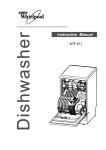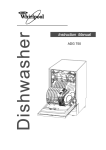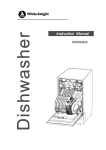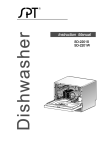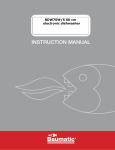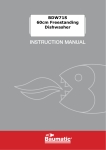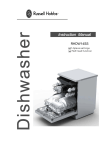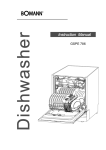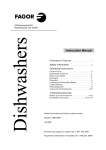Download EURO EP845DSX Instruction manual
Transcript
EP845DSX For detailed operating method read the corresponding content on the instruction manual. Switch on the appliance Fill the detergent dispenser Check the rinse aid level Load the baskets Press the On/Off button to switch on the appliance, Open the door. Compartment Fill main-wash detergent. Compartment Fill pre-wash detergent. (Follow the user instructions!) Mechanical indicator Electric indicator on control panel (if provided). Scrape off any large amount of leftover food. Soften remnants of burnt food in pans, then load the baskets. Refer to the dishwasher loading instructions. Select a programme Press the Programme button until the selected programme lights up. ( See the section entitled“Operationg instruction”) Running the dishwasher Close the door, t urn on the water tap . The machine will start working after about 10 seconds. Changing the programme 1. A running cycle can only be modified if it has been running for a short time. Otherwise the detergent may have already been released and the water already drained. If this is the case, the detergent dispenser must be refilled. 2. Press the running program button more than 3 second to cancel to cancel the running programme . 3. Select a new programme. 4. The dishwasher will restart after 10second. Add forgotten dishes in the dishwasher. 1.Open the door a little to stop the dishwasher. Open the doo r carefully. 2.After the spray arms stop working, you can open the door completely. Hot steam may esc ape 3.Add the forgotten dishes. 4.Close the door, the dishwasher will start running again after 10 seconds. when the door is opened! If the appliance is switched off during a wash cycle. If the appliance is switched off during a wash cycle, when switched on again, please re-select the washing cycle and operate the dishwasher according to the original Power-on state ). Switch off the appliance When the working cycle has finished, the buzzer of the dishwasher will sound 8 times, then stop. Turn off the appliance using the ON/OFF button. Turn off the water tap, unload the baskets Warning: wait a few minutes (about 15 minutes) before unloading the dishwasher to avoid handling the dishes and utensils while they are still hot and more susceptible to break. They will also dry better. Unload the appliance, starting from the lower basket. Dear Customer, Please carefully read this manual bef ore using the dishwasher, it will help you to use and maintain the dishwasher properly. Keep it to refer to it at a later date. Pass it on to any subsequent owner of the appliance. This manual contains sections on safety Instructions, Operating Instructions, Installation Instruc tions and Troubleshooting Tips, etc. This appliance is intended to b e used in household and similar applications such as: – sta ff kitche n areas in shops , offices and othe r wo rking environments; – farm house s; – by clients in hotels, motels and other residential type environ ments; – bed and breakfast type environments. Control Panel...................................................2 Dishwasher Fe atures.................................... ...2 A、Fill th e Rinse Aid Dispenser............. ..... .. ... ..3 B、 Function of Dete rgent ........ .........................4 Attention before or after loading the Dishwasher Baskets..........................................................6 Loading the upper Basket ...... .......... .. . ..............7 Loading the Lower Basket ...................... .. .........7 Cutlery Basket................................................8 Wash Cycle Table...........................................9 Turning on the Appliance................................10 Change the Programme.............. .... ................10 At the Ene of the Wash Cycle ...........................10 Filtering System.............................................11 Caring for the Dishwasher..................... . .........12 To review the section on troubleshooting Tips will help you to solve some common problems by yourself . If you can not solv e the problems by yourself , please ask for the help of professional technicians. Positioning the Applian ce................... .. ..........13 About Power Connection........................ . .......13 Water Connec tion.................................. . .......1 4 Start of dishwasher................................ .. ......15 Before calling for se rvice........................... . .....16 Error codes.................................... . ..............1 7 Technical in formation.............................. .. .....18 The manufacturer, following a policy of constant development a nd u pdating of the product, may make modifications without giving prior notice. When using your dishwasher, follow the precautions listed below: This appliance must be grounded. In the event of a malfunction or breakdown, grounding will reduce the risk of anelectric shock by providing a path of least resistance of electric current. This appliance is equipped with a cord having an equipmentgrounding conductor and a grounding plug. The plug must be plugged into an appropriate outlet that is installed and grounded in accordance with all local codes and ordinances. Improper connection of the equipment-grounding conductor can result in the risk of an electric shock. Check with a qualified electrician or service representative if you are in doubt whether the appliance is properly grounded. Do not modify the plug provided with the appliance; If it does not fit the outlet. Have a proper outlet installed by a qualified electrician. Do not abuse, sit on, or stand on the door or dish rack of the dishwasher. Do not touch the heating element during or immediately after use. (This instruction is only applicable to machines with a visual heating element.) Do not operate your dishwasher unless all enclosure panels are properly in place. Open the door very carefully if the dishwasher is operating, there is a risk of water squirting out. Do not place any heavy objects on or stand on the door when it is open. The appliance could tip forward. When loading items to be washed: 1) Locate sharp items so that they are not likely to damage the door seal; 2) Warning: Knives and other ute nsils with sharp points must be loaded in the basket with their points down or p lace d in a horizonta l position. When using your dishwasher, you should prevent plastic items from comin g into contact with the heating element.(This instruction is only applicable to machines with a visual heating element.) Check that the detergent comparment is empty after completion of the wash cycle. Do not wash plastic items unless they are marked dishwasher safe or the equivalent. For plastic items not so marked, check the manufacturer's recommendations. Use only detergent and rinse additives designed for an automatic dishwasher. Never use soap, laundry de terg ent, or hand washing detergent in your dishwasher. Keep these products out of the re ach of children. Keep children away from detergent and rinse aid, keep children away from the open door of the dishwasher, there could still be some detergent left inside. This appliance is not intended for use by persons (including children )with reduced physical, sensory or mental capabilities, or lack of experience and knowledge ,unless they have been given supervision or instruction concerning use of the appliance by a person responsible for their safety. Children should be supervised to ensure that they do not play with the appliance. Dishwasher deterge nts are strongly alkaline, they can be extremely da ngerous if swallowed. Avoid con tact with skin and eyes and keep children away from the dishwasher when the door is open. The door sh ould not be left o pen, since th is could increase the risk of tripping. If the supply cord is damaged, it must be replaced by the manufacturer or its service agent or a similarly qualified person in orde r to avoid a hazard. Remove the door to the washing compartment when removing an old dishwasher from service or discarding it. Please dispose of pack ing materials properly. Use the dishwasher only for its intended function. During installation, the power supply must not be exce ssiv ely or dangerously bent or flattened. Do not tamper with controls. The appliance is to be connected to the water mains u sing new hose sets and that old hose-sets sho uld not be reused. The maximum numb er of place settings to be washed is 8. The maximum permissible inlet water pressure is 1Mpa. The minimum permissible inlet water pressure is 0.04Mpa. 2.Operation Instruction IMPORTANT To get the best performance from your dishwasher, read all operating instructions before using it for the first time. Control Panel 3in1 1 Hour Normal Heavy Inten. Rapid Prog. 6 7 1 2 3 Power indicator light: To show the power supply. 5 4 3 2 1 4 Start /Reset button: To start the selected washing program or reset the washing program when the machine is working. 5 Washing Program Selector: To select one of the six washing programs. 6 Program indicator lights: To show the washing program. Power switch: To turn on/off the power supply. Rinse aid warning lights: To show when the dispenser need to be refilled Finish light:to show when the washing program is finished On / Off Start/Reset Dishwasher Features Back View Front view 1 2 3 Upper Basket Spray Arms Lower Basket 4 5 6 Main Filter Detergent Dispenser Cup Shelf 2 7 8 9 Cutlery Basket Coarse Filter Rinse Aid Dispenser 10 11 Drain pipe connector Inlet pipe connector Before using your dishwas her for the first time: A. Fill the rinse aid dispenser B. Fill in detergent Rinse Aid Dispenser The rinse aid is released during the final rinse to prevent water from forming droplets on your dishes, which can leave spots and streaks. It also improves drying by allowing water to roll off the dishes. Your dishwasher is designed to use liquid rinse aids. The rinse aid dispenser is located inside the door next to the detergent dispenser. To fill the dispenser, open the cap and pour the rinse aid into the dispenser until the level indicator turns completely black. The volume of the rinse aid container is about 110ml. Function of Rinse Aid Rinse aid is automatically added during the last rinse, ensuring thorough rinsing, and spot and streak free drying. Attention! Only use branded rinse aid for dishwasher. Never fill the rinse aid dispenser with any other substances (e.g. Dishwasher cleaning agent, liquid detergent). This would damage the appliance. When to Refill the Rinse Aid Dispenser If there is n o rinse-aid warning lig ht in the control p anel, you can judge the amount of rinse-aid by the color of the optical level indicator "C" located next to the cap. When th e rinse-aid container is full, the whole indicator will be dark .As the rinse-aid diminis hes, the size of the dark dot decreases . You should never let the rinse aid get below 1 / 4 full. As the rinse aid diminishes, the size of the black dot on the rinse aid level indicator changes, as illustrated below. Full 3 / 4 full 1 / 2 full 1 / 4 full - Should refill to eliminate spotting Empty RINSE AID DISPENSER 1 2 3 To open the dispenser, turn the cap to the "open" (left) arrow and lift it out. Pour the rinse aid into the dispenser, being careful not to overfill. Replace the cap by inserting it aligned with "open" arrow and turning it to the closed (right) arrow. Be careful not to overfill the dispenser, because this c ould cause over sudsing. Wipe away any spills with a damp cloth. Don't forget to replace the cap before you close dishwasher door. Attention! Clean up any rinse aid split during filling with an absorbent cloth to avoid excess foaming during the next wash. 3 Clean up any rinse aid spilled while during filling with an absorbent cloth to avoid excessive foaming during the next wash. Don't forget to replace the cap before you close dis hwa sher door. Adjusting Rinse Aid Dispenser The rinse aid dispenser has six or four settings. Always start with the dispenser set on "4". If spots and poor drying are a p roblem, increase the amount of rinse aid dispensed by removing the dispenser lid and rotating the dial to "5". If the dishes still are not drying properly or are show spots, adjust the dial to the next higher lever until your dishes are spot-free. The recommended setting is "4". (Factory value is "4".) Increase the dose if there are drops of water or lime spots on the dishes after washing. Reduce it if there are sticky whitis h stains on your dishes or a bluish film on glassware or knife blades. Detergents with its chemical ingredients are necessary to remove dirt, c rush dirt and transport it out of the dishwasher. Most of the commercial quality deterge nts are suitable for this purpose. Detergents There are 3 sorts of d etergents 1.With phosphate and with ch lorine 2.With phosphate and without chlorine 3.Without phosphate and without chlorine Norma lly new pulverised detergent is without phosphate. Thus the water softener function of phosphate is not given. In this case we recommend to fill salt in the salt container even when the hardness of water is only 6 °dH. If detergents without phosphate are used in the case of hard water often white spots appear on dishes and glasses. In this case please add more detergent to reach better resu lts. Detergents without chlorine do only bleach a little. Strong and coloured spots will not be removed completely. In this case please choose a program with a higher te mperature. Concentrated Detergent Based on their chemical composition, detergents can be split in two basic types: co nventional, alkaline detergents with caustic componen ts low alkaline concentrated detergents with natural enzymes The use of“normal” washing programs in combination with concentrated detergen ts reduces pollution and is good for your dishes; these wash p rograms are specifically matched to the dirt-dissolving properties of the enzymes of the concentrated detergent. For this reason “normal”wash programs in which concentrated detergents are used can achie ve the same results that c an o therwise only be achieved using “intensive” programs. Detergent Tablets Dete rgent tablets of different brands disso lve at different speeds. For this reason some detergent tablets cannot dissolve and develop their full cleaning power during short programs. There fore please use long programs wh en u sing detergent tablets, to ensure the complete removal of detergent residuals. Detergent Dispenser The dispenser must be refilled before the s tart of each wash cycle following the instructions provided in the wash cycle table . Your dishwasher uses less de tergent and rinse aid than Conventional dis hwasher. Generally, only one tablespoon of detergent is needed for a normal wash load. More heavily soiled items need mo re detergent. Always add the detergent just before starting the dishwasher, otherwise it could get damp and will not dissolve properly. Amount of Detergent to Use Detergent powder Detergent tablet If the lid is closed: press release button. The lid will sp ring open. Always add the detergent just before starting each wash cycle. Only use branded detergent aid for dishwasher. Dishwasher detergent is corrosive! Take care to keep it out of reach of children. Prop er Use of Detergent Use only detergent specifically ma de for the us e in dish was hers. Ke ep your detergent fresh and dry. Don't put powdered detergent into the dispenser until you're ready to wa sh dishes. Fill in Detergent Fill the detergent dispenser with detergent. The marking indicates the dosing levels , as illustrated on the right: A The place of main wash cycle detergent placed. B The place of pre-wash cycle detergent placed. Please observe the manufacturers dosing and storage Recommendations as stated on the detergent packaging. Close the lid and press until it locks in place. If th e dishes are heavily soiled, place an additional detergent dose in the pre-wash detergent chamber. This detergent will take effect during the pre-wash phase. You find information about the amount of detergent for the single programme on the last page. Please aware, that according to the level soiling and the specific hardness of water d ifferences are possible. Please observe the manufacturer's recommendations on the detergent packaging. Consider buying utensils which are identified as dishwasher-proof. Use a mild detergent that is described as 'kind to dishes'. If necessary, seek further information from the detergent manufacturers. For particular items, select a program with as low a temperature as possible. To prevent damage, take glass and cutlery out of the dis hwa sher as soon as possible after the program has ended. Are not suitable Are of limited suitability Cutlery with wooden, horn china or mother-of-pearl handles Plastic items that are not heat resistant Older cutlery with glued parts that are not temperature resistant Bonded cutlery items or dishes Pewter or cooper items Crystal glass Steel items subject to rusting Wooden platters Items made from synthetic fibres Some types of glasses can become dull after a large number of washes Silver and aluminum parts have a tendency to discolour during washing Glazed patterns may fade if machine washed frequently (For best performance of the dishwasher, follow these loading guide lines. Features and appearance of baskets and cutlery baskets may vary from your model.) Scrape off any large amounts o f leftover food. Soften remnants of burnt food in pans. It is not necess ary to rinse the d ishes under running water. Place objects in the dishwasher in following way: 1.Items such as cups, glasses, pots /pans, etc. are faced downwards. 2.Curved items, or ones with recesses, should be loaded aslant so that water can run off. 3.All utensils are stacked securely and can not tip over. 4.All utensils are placed in the way that the spray arms can rotate freely during washing. Very small items should not be washed in the dishwasher as they could easily fall out of the basket. Load hollow items suc h as cup s, glasses, pans etc. With the opening facing downwards so that water can not collect in the con tainer or a deep b ase. Dishes and items of cutlery must not lie ins ide one another, or cover each oth er. To avoid damage to glasse s, th ey must not touc h. Load large ite ms which are most difficult to clea n into the lower bask et. The upper basket is designed to ho ld more delicate and lighter dishware such as glasses , coffee and tea cups Long bladed knives stored in an upright position are a potential haza rd! Long and/or sharp items o f cutlery such as carving kniv es must be positioned horizonta lly in the upper b asket. Please do not ove rload yo ur dishwasher. This is important for good results and for reasonab le consumption of energy. To prevent water dripping from the uppe r basket into the lower basket, we recommend that you empty the lower basket first and then the upper basket. The upper basket is designed to hold more delicate and lighter dishware such as glasses, coffee and tea cups and saucers, as well as plates, small bowls and shallow pans (as long as they are not too dirty). Position the dishes and cookware so that they will not be moved by the spray of water. 3 3 Cups 1 3 2 1 1 1 2 Saucers 1 3 3 Glasses 2 We suggest that you place large items and items that are the most difficult to clean into the lower basket such as: pots, pans, lids, serving dishes and bowls, as shown in the figure below. It is preferable to place serving dishes and lids on the side of the racks in order to avoid blocking the rotation of the top spray arm. Please be reminded that: Pots, serving bowls, etc, must always be placed top down. Deep pots should be s lanted to allow water to flow out. The Bottom Basket features folding spikes so that la rger or more pots and pans can be loaded. 5 6 4 4 7 4 5 Dessert dishes Soup plates 6 Dinner plates 7 Cutlery basket Adjusting the Upper Basket The height of the upper basket can be adjusted in order to create more space for large utensils both for the upper/lower basket. The height of the upper basket can be adjusted by placing the wheels on different h eight of the rails. Long items, serving cutlery, salad servers and knives should be placed on the shelf so that they do not obstruct the rotation of the spray arms. The shelf can be folded back or be removed when not requ ired for use. Folding Spikes of Lower Basket For better stacking of pots and pans, the spikes can be folded down as show in the picture right. Cutlery Basket Cutlery should be placed in the cutlery basket with the handles at the bottom. If the rack has side baskets, the spoons should be loaded separately into the appropriate slots, especially long utensils should be placed in the horizontal position at the front of the upper basket as shown in the picture. 1 4 5 1 4 1 4 5 1 4 5 1 4 1 4 5 1 4 5 1 4 3 3 5 2 2 2 2 2 2 3 3 5 2 3 3 3 3 5 2 1 Forks 2 Soup spoons 3 Dessert spoons 4 Teaspoons 5 Knives Do not let any item extend through the b ottom. Always load sharp utensils with the sharp point down! For personal safety and a top quality cleaning, place the silverware in the basket making sure that: They do n ot nest together. Silverware is placed with the handles-down. But place knives a nd other potentially dangerous utensils are placed handles-up. 5.Starting a washing program Wash Cycle Table Cycle Selection Information Program 3in1 Description of Cycle Pre-wash 50 For commonly soiled loads,Use multifunctional wash 50 rinse detergent Detergent Running pre/main time(min) 3in1 150 Energy (Kwh) 1.0 Water (L) Rinse Aid 12 rinse 70 drying For heaviest soiled crockery, and normally Intensive soiled pots pans dishes etc with dried on soiling; Heavy Normal (*AS/NZS 2007.1) 1 Hour For heavily soiled loads, such as pots, plates, glasses and lightly soiled pans. Standard daily cycle for normally soiled loads, such as pots plates glasses. Pre-wash(50 Pre-wash Wash (65 ) Rinse Rinse Rinse (55 ) Drying ) Pre-wash(50 Wash (50 ) Rinse Rinse (65 ) Drying ) Pre-wash Pre-wash Wash (55 Rinse (50 Drying ) ) Wash(60 ) For lightly soiled loads that do not need excellent Rinse Rinse (50 ) drying efficiency. 5/20g 120 5/20g 150 1.0 12 5/20g 120 0.64 12.2 15g 60 0.6 9 15g 30 0.4 10 1.2 18 Drying Rapid A shorter wash for lightly soiled loads and quick wash. Wash (40 Rinse Rinse (45 ) ) NOTE: ( ) Meaning: need to fill rinse into the Rinse-Aid Dispenser. *AS/NZS 2007.1: This programme is the test cycle. The information for comparability test in accordance with AS/NZS 2007.1 , as follows: Capacity: 8 setting Position Upper basket: upper wheels on rails Rinse aid setting: 6 NOTE: We recommend you open the door slightly 50mm to assist in drying of the dishes after every wash. 9 1 Draw out the lower and upper basket, load the dishes and push them back. It is commended to load the lower basket first, then the upper one (see the section entitled “Loading the Dishwasher”) . 2 Pour in the detergent (see the section entitled“Detergent and Rinse Aid”). 3 Insert the plug into the socket. The power supply is 220-240 VAC /50 HZ, the specification of the socket is 10A 250VAC. Make sure that the water supply is turned on to full pressure. 4 Close the door , and select the desired programme by pressing the corresponding button, then the dishwasher will start to work in 3 second. Premise: 1 You can modify the washing program, When the dishwasher just runs for a short time. Otherwise, the detergent may have already been released, and the appliance may have already drained the wash water. If this is the case, the detergent dispenser must be refilled (see the section entitled " Loading the Detergent " ). 2 Press the button of desired program more than 3 seconds until it's Indicator is on , after 10 seconds the machine will keep working. E ntitled " Starting a wash cycle. . . " ). If yo u open the d oor during washing, the machine will pause. When you close the door , the machine will keep on working after 10 seconds. . The program lights show the state of the dishwasher: a) All program lights off---------------stand by b) One of the program lights on----------pause c) One of the program lights blinking----- run If all the lights begin to glimmer, that indicates the machine is ou t of orde r, please turn off the main power and water supply before calling a service. . A forgotten dish can be added at any time before the detergent cup opens. 1 2 Open the door a little to stop the washing. 3 Load the forgotten dishes. After the spray arms stop working, you can open the door completely. 4 Close the door, the dishwasher will start running again after 10 seconds. When the working cycle has finished, the buzzer o f the dishwasher will sound for 8 seconds, the n stop. Turn off the appliance using the ON/OFF button, shut off the water supply and open the door of the dishwasher. Wait for a few minutes before unloading the dishwash er to avoid ha ndling the dishes and utensils while they are still hot and more susceptible to break age. They will also d ry better. Switch Off the Dishwasher The buzzer of the dishwasher moos for 8 seconds, only in this case the programme has ended. 1.Switch off the dishwasher by pressing the ON/OFF button. 2.Turn off the water tap! Open the door carefully. Hot dishes are sensitive to knocks. The dishes should therefore be allowed to cool down arou nd 15 minutes before removing from the appliance. Open the dish was her's door, leave it ajar and wait a few minutes before removing the dis hes. In this way they will be cooler and the drying will be improved. Unloading the dishwasher It is normal that the dishwashe r is wet insid e. Empty the lower basket first and then the upper one. This will avoid water dripping from the upper Bas ket onto the dishes in the lower one. It is dangerous to open the door when washing, because the hot water may scald you. The filter prevents larger remnants of food or other objects from getting inside the pum. The residues may block the filter, in this case they must be removed. The filter system consists of a coarse filter,a flat (Main filter) And a microfilter(Fine filter). Main filter 2 1 Fo od and soil particles trap ped in this filter are pulverized by a specia l jet on the lower spray arm and washed down to drain. 1 Coarse filter 2 La rger ite ms, such as p ieces of bones or glass, that could block the drain are trapped in the coarse filter. To remove the items caught by the filter, gently squeeze the tap on the top of this filter and lift out. 3 Fine filter 3 This filter holds soil and food residues in the sump area a nd preve nts it from being redeposit on the dishes during wa sh cycle. Filter assembly The filter efficiently re mo ves food particle s from the wash water, allowing it to be rec ycled during the cycle. For best performance and results, the filter must be cleaned re gularly. For this reason, it is a goo d idea to remove the larger food particles trapp ed in the filter after e ach was h cycle by rinsing the semicircular filter and cup under runnin g water. To remove the filter device, pull the cup handle in the upward d irection. The d ishwasher must never b e used without the filters. Improper replacement of the filter may reduce the performance level of the appliance and damage dishes and utensils. 1 Step 1:Turn the filter in anti-clockwise direction, then lift it u p. 2 Step 2:lift the Main filte r up 3 Step 3: lift the F ine filter up When following this procedure from step1 to step 3, the filter system will be removed; when following it from Step 3 to Step 1, the filter system will be installed. Remarks: - Inspect the filters for blo cking a fter e very time the dishwa sher has been used. - By unscrewing the coarse filter, you can remove the filter system. Re move any foo d remna nts and clean the filters under running water. The entire filter assembly should be cleaned once a week. Cleaning the Filter To clean the coarse filter and the fine filter, use a c leaning b rush. Reassemb le the filter p arts as shown in the figures on the last page and reinsert the entire assembly in the dis hwa sher, positio ning it in its seat and pressing downwards. When cleaning the filters, don't knock on them. Otherwise, the filters could be contorted and the performance of the dishwasher could be decreased. The control panel can be cleaned by using a lightly dampened cloth. After cleaning, make sure to dry it thoroughly. For the exterior, use a good appliance polish wax. Never use sharp objects, scouring pads or harsh cleaners on any part of the dishwasher. Cleaning The Door To clean the e dge around the door, you should use only a soft warm, damp cloth. To avoid pene tration o f wa ter into the door lock and electrical components, do not use a spray cleaner of any kind. Never use a spray cleaner to clean the door panel as it may damage the door loc k and electrical components. Abrasive agents or some paper towels shou ld not be used becau se of the risk of scratching or leaving spots on the stainless steel surface. Protect Against Freezing please take frost protection measures on the dishwasher in winter. Every time a fter washing cycles, please operate as follows: 1.Cut off the electrical power to the dishwasher. 2.Turn off the water supply and disconnect the water inlet pipe from the water valve. 3.Drain the water from the inlet pipe an d water valve. (Use a pan to catch the water) 4.Reconnect the water inlet pipe to the water valve. 5.Remove the filter at the bottom of the tub and use a sponge to soak up water in the sump. If your dishwasher cannot work because of the ice, please contact professional service persons. Cleaning the Spray Arms It is necessary to clean the spra y arms re gularly fo r hard wate r che micals will clog the sp ray arm jets and b earin gs. To remove the spray arms, screw off the nut cloc kwise to take out the washer on top of the spray arm a nd remove the arm. Wash the arms in soap y and warm water and use a soft brush to clea n the jets . Replac e them after rinsing them thoro ughly. 2 1 1 2 After Every Wash When not in Use for a LongTime After every wash, turn off the water supply to the appliance and leave the door slightly open so that moisture and odours are not trapped inside. It is recommend that you run a was h cy cle with the dishwasher empty an d the n remove the plug from the socket, turn off the wa ter supply and leave the door of the appliance slightly open. This will help the d oor seals to last longer and prevent odours from forming within the appliance. Remove the Plug Before cleaning or performing maintenance, always remove the plug from the socket. No Solvents or Abrasive Cleaning To cle an the e xterior a nd rubber p arts of the dishwasher, do not use solvents or abrasive cle aning products. Only use a clo th with warm so apy water. To remove spots o r stains from the surface of the interior, use a cloth da mpened with water a n a little vinegar, o r a cleaning pro duct mad e specifically for dishwashers. Moving the Appliance If the appliance must be moved, try to keep it in the vertical position. If absolutely necessary, it can be positioned on its back. Seals One of the factors that cause odours to form in the dishwasher is food that remains trapped in the seals. Periodic cleaning with a damp sponge will prevent this from occurring. Position the appliance in the desired location. The back should rest against the wall behind it, and the sides, along the adjacent cabinets or walls. T he dishwasher is equipped with water supply and drain hoses th at can be positioned either to the righ t or the left sides to facilitate proper installation. Once the appliance is positioned for levelling, the height of the dishwashe r may be altered via adjustment of the screwing level of the feet. In any case, the applia nce should not be inclined more than 2 . For personal safety: DO NOT USE AN EXTENSION CORD OR AN ADAPTER PLUG WITH THIS APPLIANCE. DO NOT, UNDER ANY CIRCUMSTANCES, CUT OR REMOVE THE EARTHING CONNECTION FROM THE POWER CORD. Plea se look at the rating label to know the rating voltage and connect the dishwasher to the appropriate power supply. Use the required fuse 10 amp , time delay fuse or c ircuit breaker recommended and provide separate circuit serving only this appliance. Ensure the voltage and frequency of the power being correspond s to those on the rating plate. Only in sert the plug into an electrica l socke t which is earthed prop erly. If the electrical socket to which the appliance must be connected is not appropriate for the plug , replace the socket, rather than using a a daptors or the like as they could cause ove rheating an d burns. This appliance must be earthed. In the event of a malfunction or breakdown, earthing will reduce the risk of electric shock by providing a path of least resistance for the electric current. This appliance is equipped with a cord having an equipment-earthing conductor and an earthing plug. The plug must be plugged into an appropriate outlet that is installed and earthed in accordance with all local standards and requirements. Improper connection of the equipment earthing conductor can result in the risk of an for personal safety: electric shock. DO NOT USE AN EXTENSION CORD OR AN ADAPTER PLUG WITH THIS APPLIANCE. Check with qualified electrician or service representative if you areTHE in doubt whether the DO a NOT, UNDER ANY CIRCUMSTANCES, CUT OR REMOVE EARTHING appliance is properly earthed. CONNECTION FROM THE POWER CORD. Do not modify the plug provided with the appliance. If the plug does not fit properly to the outlet, please have a qualified electrician to install a proper outlet. Connect the cold water supply hose to a threaded 3/4(inch) connector and make sure that it is fastened tightly in place. If the water pipes are new or have not been used for an extended period of time , let the water run to make sure that the water is clear. This precaution is needed to avoid the risk of the water in let to be blocked and damage the a ppliance. Please close the hydrant after using. Insert the drain hose into a drain pipe with a minimum diameter o f 4 cm, o r let it run into the sink, making sure to avoid bendin g or crimping. Use the special plas tic support that comes with the appliance. The top of the ho se must be at a height between 40 and 100 cm.The free end of the hose must not be immersed in water. SINK DISHWASHER POWER OUTLET Inlet pipe connector Drain pipe connector FRONT VIEW Min 100mm How to Drain Excess Water From Hoses If the sink is 1000 higher from the floor, the excess water in hoses cann ot be drained dire ctly into the sink. It will be necessary to drain excess water from hoses into a bo wl o r suitable container that is held outside and lower th an the sink. Water Outlet Connect the water drain hose. The drain hose mu st be correctly fitted to avoid water leaks. Ensure that the water dra in hose is no t kin ked or squashed. Extension Hose If you need a drain hose extension, make sure to use a similar drain hose. It must be no longer than 4 metres; otherwise the cleaning effect of the dishwasher could be reduced . Syphon Connection The waste connection must be at a he ight of between 40 cm (minimum) and 100 cm (ma ximum) from the bottom of the dish. T he water drain ho se should b e fixed by a hose clip. The free end of the hose must not be immersed in water. The following things should be checked before starting the dishwasher. 1 The dishwasher is level and fixed properly 2 3 4 5 6 7 The inlet valve is open There is a leakage at the connections of the conducts The wires are tightly connected The power is switched on The inlet and drain hoses are knotted All packing materials and printings should be taken out from the dishwasher After installation, please make sure to keep this manual. The content of this manual is very helpful to the users. Fuse blown, or the circuit breaker acted Replace fuse or reset circuit breaker. Remove any other appliances sharing the same circuit with the dishwasher Power supply is not turned on Make sure the dishwasher is turned on and the door is closed securely. Make sure the power cord is properly plugged into the wall socket. Error code:E1; Water pressure is low Check that the water supply is connected properly and the water is turned on. Door of dishwasher not properly closed. Make sure to close the door properly and latch it. Kink in drain hose Check drain hose. Filter clogged Check coarse the filter (see section titled " Cleaning The Filter ") Kitchen sink clogged Check the kitchen sink to make sure it is draining well. If the problem is the kitchen sink not draining ,you may need a plumber rather than a serviceman for dishwashers. Improper detergent Use only the special dishwasher detergent to avoid suds. If this occurs, open the dishwasher and let suds evaporate. Add 1 gallon of cold water to the tub. Close and latch the dishwasher, then Start the "soak" wash cycle to drain out the water . Repeat if necessary. Spilled rinse-aid Always wipe up rinse-aid spills immediately. Detergent with colourant was used Make sure that the detergent is the one without colourant. Hard water minerals To clean the interior, use a damp sponge with dishwasher detergent and wear rubber gloves. Never use any other cleaner than dishwasher detergent for the risk of foaming or suds. The affected items are not corrosion resistant. Always run the quick wash programme . A programme was not without any crockery in the dishwasher and run after dishwasher salt was added. without selecting the Turbo function (if present), after adding dishwasher salt. Traces of salt have gotten into the wash cycle. The lid of the softer is loose Check the lip .Ensure the fix is fine. A spray arm is knocking against an item in a basket Interrupt the programme, and rearrange the items which are obstructing the spray arm. Items of crockery are loose in the wash cabinet Interrupt the programme, and rearrange the items of crockery. This may be caused by on-site installation or the cross-section of the piping. This has no influence on the dishwasher function. if in doubt, contact a suitably qualified plumber. The dishes were not loaded correctly. See notes in " Loading the Dishwasher Baskets ". The programme was not powerful enough. Select a more intensive programme. See" Wash Cycle Table ". Not enough detergent was dispensed. Use more detergent, or change your detergent. Items are blocking the path of spray arms. Rearrange the items so that the spray can rotate freely. The filter combination in the base of wash cabinet is not clean or is not correctly fitted. This may cause the spray arm jets to get blocked. Clean and/or fit the filter combination correctly. Clean the spray arm jets. See "Cleaning the Spray Arms". Combination of soft water and too much detergent. Use less detergent if you have soft water and select a shortest cycle to wash the glassware and to get them clean. Aluminum utensils have rubbed against dishes. Use a mild abrasive cleaner to eliminate those marks. Dishes block detergent cups. Re-loading the dishes properly. Improper loading Load the dishwasher as suggested in the directions. Too little rinse-aid Increase the amount of rinse-aid/refill the rinse-aid dispenser. Dishes are removed too soon Do not empty your dishwasher immediately after washing. Open the door slightly so that the steam can escape. Begin unloading the dishwasher only once t he dishes are barely warm to the touch. Empty the low basket first. This prevents water form dropping off dishes in the upper basket. Wrong program has been selected In short program the washing temperature is lower. This also lowers cleaning performance. Choose a program with a long washing time. Use of cutlery with a low-quality coating Water drainage is more difficult with these items. Cutlery or dishes of this type are not suitable for washing in the dishwasher. Longer inlet time. Faucets is not opened, or water intake is restricted, or water pressure is too low. Overflow. Some element of dishwasher leaks . If overflow occurs, turn off the main water supply before calling a service. If there is water in the base pan because of an overfill or small leak, the water should be removed before restarting the dishwasher. Height : Width : Depth : 850mm 450mm 580mm Water pressure: Power supply: Capacity: 0.04-1.0MPa see rating label 8 place settings





















